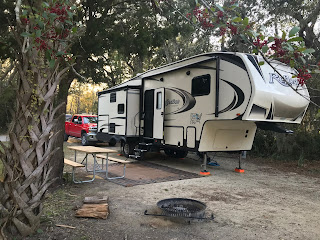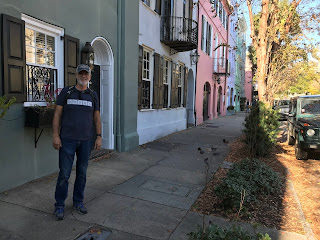Doing the Charleston!
December 9 - 16, 2020
During our stay in Charleston, SC , we made James Island County Park our home. I had read about this campground on line and it did not disappoint! Unexpectedly, it offered a Christmas light show, hiking/biking trails, a dog park, as well as typical campground amenities. The light show was out of this world with over 700 light displays! Cars back up for miles to get into the park, paying $20 to drive through. As a camper, we had free access to it! We couldn’t resist, driving through it three different evenings – seeing new details each time!
We only had a week in this area, so we really had to prioritize our time! We decided to take a trip to Charleston Tea Plantation, which is the only major tea producer in the US. It was interesting to see the tea bush, learn about the harvesting and processing of the leaves, and taste the final product.
This region is referred to as the Lowcountry (the region located below the Sandhills) and seems to take a lot of pride in their identity. I can certainly understand their pride in the food of the Lowcountry, as we fell in love with She Crab Soup as well as Shrimp and Grits! Both are delicious!
Fort Sumter is well known as the site where the Civil War began. We couldn’t resist taking a tour and learning the history of the fort. Our lessons began right off the bat, as little did we know the fort is located on a man-made island! We were able to take a ferry ride to the island to tour it. Fort Sumter was commissioned to be built after the War of 1812 revealed coastal weakness from invasion. Local plantations were hired to produce the bricks for the construction. So sad, as some of the bricks bear the fingerprints of slave children who made them. I’ll include a photo of a brick with what is believed to be the fingerprints of a five-year-old child. There were also three artillery shells still imbedded in the wall. The fort was used until the end of WWII and is now a National Monument.
The CSS Hunley submarine was another interesting piece of history we have been hearing about. So naturally, we ended up spending a morning touring the Hunley exhibit and learning about what was the world’s first successful combat submarine (1864). I hesitate to use the term successful, as the eight-man crew lost their lives in the mission; however, they were successful in sinking the Housatonic (one of the Union ships blockading the harbor). The submarine was located and eventually raised in 2000. The eight men aboard were finally put to rest in what was called the last military burial of Confederate soldiers. It remains a mystery as to what caused their death.
Following the Hunley tour, we stopped in Historic Charleston and took a horse-drawn carriage ride through the area. We learned a lot about the history of Charleston and also about the architecture. Charleston is nicknamed "The Holy City" for the large number of churches in the area. Scanning the skyline as you approach the city highlights this nickname as, instead of the typical skyscrapers defining the skyline, there are steeples scattered across the horizon. I’m not much for ghost tours but, apparently, the old jail house is the most haunted building in the US. Many of the houses in the area seem to support this idea as it was common to see the ceiling of porches painted haint blue (a term believed to be derived from haunt) to ward off spirits. It turns out spirits can’t cross water and haint blue gives the appearance of water.
The campground offered shuttle rides to downtown Charleston, saving us the stress and expense of parking, so we spent a day walking to several of the sites we saw on the carriage ride plus a few others. These included the Market, mass at the Cathedral of St. John the Baptist, the cemetery at St. Michael's Episcopal Church where John Rutledge (signatory to the US Constitution) is buried, White Point Gardens, The Battery, Rainbow Row, historic homes, the Slave Mart, lunch at A.W. Shucks (yes! Lowcountry food), and a little shopping! We also walked past the “4 corners of the law” (St. Michael’s, City Hall, the County Court House, and the Federal Court House – or as the locals say, “You can go here to get married, get taxed, get divorced and go to jail”!). That’s a pretty busy intersection!
The weather was sunny and a bit chilly for much of our stay, but we did have one afternoon where the weather warmed up enough for us to take a trip to Folly Beach and get our feet wet! Frankie loves to chase the waves and came back a sandy mess! I guess it’s all part of beach life. Near Folly Beach is Bowmans Island restaurant where we did take-out for out last meal in the area. You guessed it -- seafood was the menu and we enjoyed their shrimp platter as well as more Shrimp and Grits! What an end to a lovely stay in Charleston!
Next up: Savannah, GA
































Comments
Post a Comment